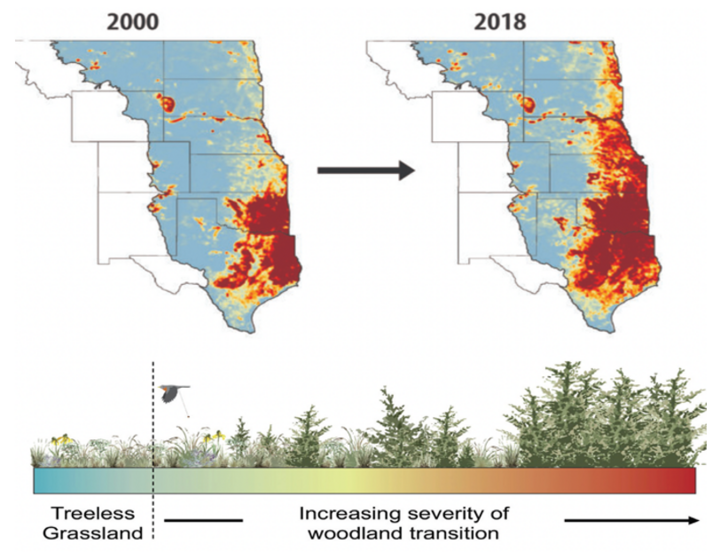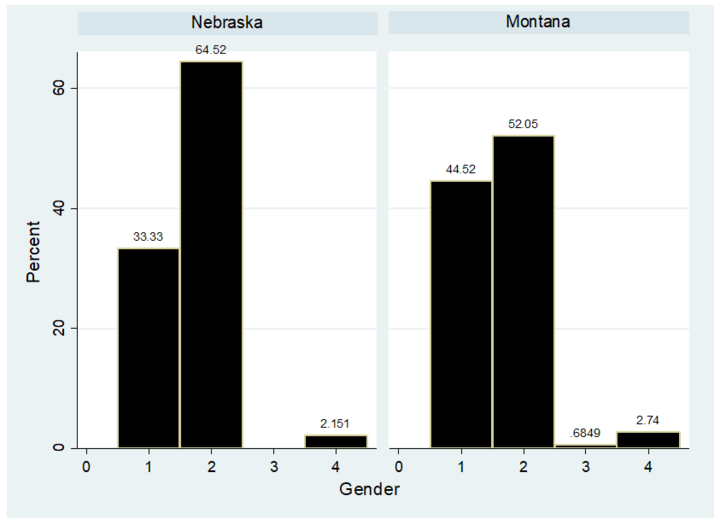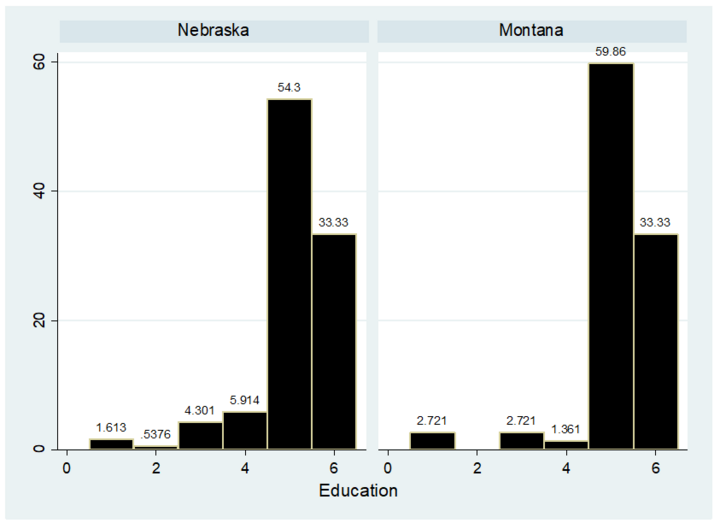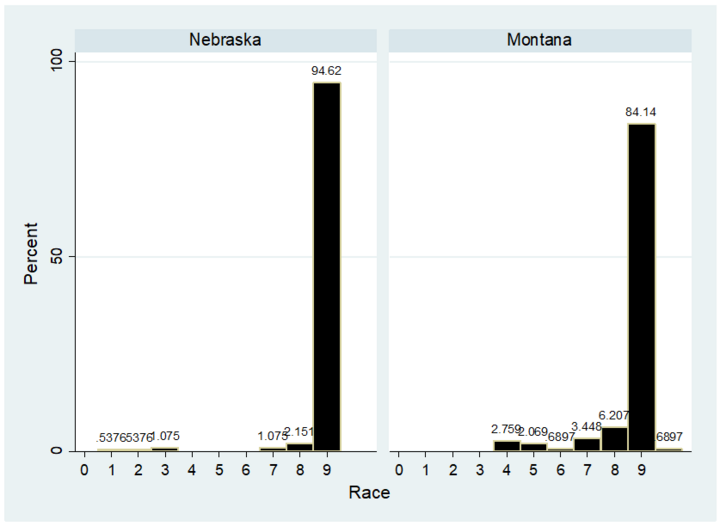By Anubrata Deka (Flame University, India), Simanti Banerjee (University of Nebraska-Lincoln) and Theresa Floyd (University of Montana)
Acknowledgement: This study is funded by the National Science Foundation's Established Program to Stimulate Competitive Research (EPSCoR) under Grant No. 1920938. The findings, conclusions, or recommendations expressed in this material are those of the author(s) and do not necessarily reflect the views of the National Science Foundation. We thank Gwendr Meredith, Daniel Uden, Craig Allen, Dirac Twidwell (University of Nebraska), Brian Chaffin and Alex Metcalf (University of Montana), and Holly Nesbitt and Emily Rowen (Boise State University) for their inputs on survey design and implementation.
Introduction:
Rangeland ecosystems cover an estimated 30–40% of the global land area and support the livelihoods of 1 to 2 billion people (Sayre et al., 2013). However, these ecosystems are increasingly threatened by undesirable vegetation transitions (UVTs), a phenomenon in which invasive and non-native plant species displace native vegetation. These transitions lead to reduced forage availability, altered ecosystem functions, and significant economic losses for agricultural producers who depend on rangelands. For example, the U.S. Great Plains rangelands have seen invasive woody species encroachment contributing to both environmental degradation and economic instability (USDA, 2021). Figure 1 presents a map of the incidence of UVTs from 2000 to 2018 across multiple U.S. states, illustrating the growing severity of the issue. Work by Gulab (2023) and Nesbitt et al. (2024) has looked at the role of producers and their social networks in Nebraska in managing the transitions on their operations. Yet, effective management of this phenomenon on a landscape scale in a sustained fashion will require a social response involving engagement of both producers and policy makers (Weir et al. 2016).
Legatzke et al. (2025) present findings on the role that policy makers, notably conservation agency professionals, can play in addressing this issue. Their study focuses on professionals in Nebraska and Montana - two states significantly impacted by transitions and examines how these individuals’ perspectives vary based on their organizational affiliations – formal and informal. Formal organizations include local, state, and federal government agencies, while informal ones include academic organizations and NGOs. Again, Rowen (2023) finds that the incidence of UVTs on the landscape and perceptions around negative impacts significantly promote adaptation attitudes of professionals in Nebraska.
Our research builds on this work by identifying this stakeholder group’s perceptions regarding their organizations’ priorities as related to UVTs management as well as the barriers that may deter their organizations from considering policy initiatives to manage UVTs. In our study area, initiatives could involve (but not limited to) the adoption of low-cost open-access mapping technology to monitor vegetation transitions.[1] By presenting information from our unique data set, we obtain an emergent understanding of the context within which policy implementation associated with management initiatives must occur to address any large-scale ecological change in general and UVTs in the U.S. Great Plains in particular.
Description of the Conservation Professional Survey:
Given our goal of assessing professionals’ attitudes towards policy implementation, our survey consisted of multiple sections asking questions about their perceptions regarding the incidence of and the harmful impacts of UVTs, their perceptions about different organizational priorities, and the barriers to policy initiatives. When measuring these variables in our survey, unless otherwise mentioned, we adopted five-point type Likert-scale questions (1 = strongly disagree to 5 = strongly agree).
We began by asking respondents about their awareness of the different types of transitions they have observed in their career as a conservation professional - transitions from native grass to woody trees, and to invasive grass species. Both transition types are present in Nebraska and Montana, though one tends to be more prevalent in each respective state. We then queried people on their levels of agreement regarding the impact of UVTs on rangeland agricultural profitability and ecosystems. Responses to these questions are crucial because if professionals don’t believe in the existence of transitions and/or their negative impact, they are unlikely to focus their policy-making efforts on this issue.
Figure 1. Woody encroachment from 2000 to 2018 (NRCS, 2021)

Our survey also asked respondents to express their agreement with the importance of different policy priorities when considering initiatives aimed at managing vegetation transitions on the landscape. For this purpose, we asked them “when considering initiatives associated with managing vegetation transitions on the landscape, my organization prioritizes... and provided a list of priorities including i) technology adoption to track the incidence of UVTs in space and time, ii) reduction in transaction costs of initiatives, iii) a focus on not widening disparities between stakeholder groups, iv) cost-effectiveness i.e. attaining the biggest bang for the buck and v) transparency in communication with stakeholders such as producers about the initiatives. As noted, we are particularly interested in technology adoption owing to the presence of low-cost, freely available mapping tools developed by Uden et al. (2019), which can be used by professionals (and ranchers) to track the transitions and take appropriate actions (for example management strategies such as mechanical removal of plants, chemical application, prescribed burning, and rotational grazing to mention a few). Reduction in transaction costs of policy initiatives is also key, as these can be a deterrent to new policy initiatives (McCann 2013). Moreover, since UVT impacts are felt on the landscape scale, it is possible that their negative impacts will be felt by many producers of different socio-economic backgrounds. Thus, if UVT management policies are to be sustainable, they should not widen disparities between stakeholder groups. Next, we are interested in cost-effectiveness because agencies typically operate under budget constraints. Finally, transparency is essential—both as a normative ideal and as a practical necessity in our context, where professionals often have long-standing relationships with peers and with producers who are directly affected by UVTs. In fact, Messer et al. (2016) and Grand et al. (2017) find that professionals place greater priority on fairness and transparency than cost-effectiveness despite organizational budget constraints, providing context for considering these priorities in our work.
Moving on, with an eye towards unpacking factors influencing policy making, we collected information on the different barriers to the same. We asked the question “When considering initiatives associated with managing vegetation transitions on the landscape, my organization faces the following barriers...” and focused on barriers such as i) budget constraints, ii) bureaucratic red tape, iii) other administrative burdens, iv) labor constraints both in terms of number and expertise relevant to UVT management, v) technological constraints, vi) intra-organizational doubts regarding the success of initiatives to manage the transitions and vii) lack of effective communication within and outside the organization with other stakeholders. Finally, we collected data on respondents’ perceptions of trust—both internal (within their organizations) and external (across organizations and with stakeholders)—to better understand how inter- and intra-organizational trust may influence the capacity for collaborative policy implementation.[2]
Description of Survey Implementation:
For data collection, we developed a contact list of 1370 conservation professionals from public websites in Nebraska and Montana. These individuals had affiliations to various conservation organizations, namely academia, federal, state, and local environmental agencies, NGOs, and others. Then we used a chain-link referral protocol (Biernacki and Waldorf, 1981), whereby respondents had the option to refer the survey to their contacts, post completion. Ultimately, we got a final data set of responses made up of 335 professionals. The survey was conducted between October and December 2022 in Qualtrics.
Figure 2: Distribution of Respondents by Gender

Figure 3: Distribution of Respondents by Education

Figure 4: Distribution of Respondents by Race

Survey Findings:
In our data set, most of our respondents are males with a 4-year college degree, with most of them not declaring their race.[3] The histograms in Figures 2, 3, and 4 provide information on the percentage of observations in the category for each of these three demographic variables, respectively. Table 1 presents summary information on the average and median age of respondents as well as their years of experience in the organization in which they work and their overall experience in the conservation field.
Next, we find in Table 2 that, on average, respondents in each state mostly agreed about the incidence of different types of UVTs during their lifetime experience as a conservation professional, with a median value of at least 4 and with negative skewness. Consistent with known ecological patterns, respondents in Nebraska reported greater agreement regarding the presence of invasive plants and trees (average = 4.34) while those in Montana showed higher agreement on transitions to invasive annual grasses (average = 4.27). Furthermore, there is broad overall agreement about the harm to agricultural productivity and rangeland ecosystems from transitions in both states (average value is greater than 4.2, with a median of 5 and negative skewness for both types of impacts). In fact, these findings are aligned with similar values of perceptions recorded for producers in Nebraska in a survey conducted to evaluate perceptions about UVTs in 2021 (Gulab 2023).
Given this overall awareness regarding the incidence of UVTs and the negative impacts of the same, we next examine perceptions around policy priorities, as summarized in Table 3. We find that across all priorities, other than the one pertaining to lowering transaction costs, the average value is at least 3, if not higher, with a median of mostly 4 (except for Montana for technology use), and the distribution of responses is negatively skewed. Thus, while our data set does not allow us to establish ranking across policy priorities within an agency, we find, on average, broad agreement regarding attention to these priorities when professionals consider initiatives to manage UVTs. Focusing on lowering transaction costs, the average value is less than 3 with a median value of 3 and negative skewness for Nebraska and positive skewness for Montana (although the values are closer to zero than one). This is an interesting result and suggests that while there is a group of professionals who perceive that their organizations prioritize reducing transaction costs, there is a more or less equal sized group who disagree with the importance of this aspect of policy making. This finding possibly suggests that these professionals perceive that their organizations would consider UVT management policy initiatives notwithstanding the associated transaction costs.
Building on this discussion, we turn to the barriers reported by respondents as impacting consideration of different policy initiatives in the two states. Here we find from Table 4 that professionals overall are neutral or agree with the presence of various barriers to policy implementation. The distribution of responses for the barrier associated with budget constraints is negatively skewed with a median value of 4 and an average of at least 3.5, indicating the importance of addressing this barrier if any meaningful policy initiatives to address UVTs are to be considered. In fact, in the data, approximately 83% of respondents in both states believe that budgets are a constraint for their organizations. Similar responses are obtained for organizational bureaucracy and administrative costs. Interestingly, when considering the lack of expertise of personnel who would implement policies, the average and skewness of the distribution are different across states, although for both states, the median value is still 3. In Nebraska, the average is 2.77 (with positive skewness), implying that professionals, on average, disagree with the statement that their organizations’ employees lack training and expertise to address UVTs, or they are neutral about this issue. Conversely, in Montana, the perception is opposite (the average is 3.13 with negative skewness). Regardless of this finding, however, professionals in both states agree (or are neutral) that there are not enough people to implement initiatives. These preliminary findings indicate that policy initiatives to manage large-scale UVTs on the landscape suffer from both a lack of people who would deploy initiatives (both states) and limited or incomplete scientific expertise of existing professionals (Montana). This finding speaks to the need for increased recruitment of organizational staff and training and capacity building if policies to manage UVTs are to be implemented for greater success.
Next, professionals don’t perceive a lack of technology to manage UVTs as a major barrier, given the average value is less than 3 and the distribution is positively skewed. Nor do they express strong concerns about intra-organizational doubts regarding the success of UVT initiatives. Finally, focusing on the lack of intra-organizational communication between employees as well as engagement with stakeholders outside of the organization, the average values are less than three with positive skewness (median value is 3). Thus, overall, it seems that respondents mostly disagree that there are limited channels of communication both within and across organizations and stakeholder groups. This is an encouraging finding since transparent communication with stakeholders is an important policy priority when considering UVT management initiatives. In fact, in Table 3, the average value for this priority is the highest for both states across all priorities. This finding provides a segue into considering the role of agency professionals’ perceptions of trust. Specifically, Table 4 indicates that, on average, professionals are mostly either neutral or in agreement with statements pertaining to the presence of trustworthy relationships between professionals within and across agencies and with stakeholders. And in all cases, the median value is 4 with the distribution being negatively skewed. This is a critical insight. Given that UVTs are large-scale ecological phenomena requiring sustained coordination across diverse stakeholder groups, the presence of trustworthy relationships provides a strong foundation for the successful implementation of management initiatives.
Conclusion and Next Steps:
In this bulletin, we have provided a descriptive analysis of the perceptions of conservation professionals in Nebraska and Montana, two states where the rangeland ecosystem is facing a large-scale transition from native grasses to invasive trees and grasses. This analysis provides an initial understanding of the different factors that can influence adoption of policy initiatives by conservation professionals. When considered alongside insights into the management behaviors of ranchers—whose productivity and profitability are adversely affected by these transitions—this information helps form a more comprehensive picture of the ecological and economic impacts of UVTs, as well as strategies for their mitigation. In the next step, our goal is to analyze data from questions about respondents’ social networks to evaluate how the structure and composition of their networks influence policy priorities and barriers, and how those are related to their perceptions of trust. This analysis will be conducted for both states while controlling for respondent-level characteristics and other variables in the data set, thereby deepening our understanding of how personal, environmental, and social factors influence professionals’ approaches to UVT management on the landscape.
References:
Biernacki, P., & Waldorf, D. (1981). Snowball sampling: Problems and techniques of chain referral sampling. Sociological methods & research, 10(2), 141-163.
Grand, L., Messer, K. D., & Allen III, W. (2017). Understanding and overcoming the barriers for cost-effective conservation. Ecological Economics, 138, 139-144.
Gulab, Sabrina, "Essays on the Social Networks and Technology Adoption" (2023). ETD collection for University of Nebraska-Lincoln. AAI30575717. Date Accessed: July 23rd, 2025. https://digitalcommons.unl.edu/dissertations/AAI30575717/.
Legatzke, H., Chaffin, B.C., Floyd, T.M., Banerjee, S., Church, S., Gulab, S., Hamlin, S., Meredith, G.R., Metcalf, A.L., Nesbitt, H.K. and Sutherland-Rowen, E., Uden, D.R., & Allen, C.R. (2025). Governance of a landscape: The role of formal and informal organizations. Journal of Environmental Management, 380, 124974.
McCann, L. (2013). Transaction costs and environmental policy design. Ecological Economics, 88, 253-262.
Messer, K. D., Allen III, W. L., Kecinski, M., & Chen, Y. (2016). Agricultural preservation professionals' perceptions and attitudes about cost-effective land selection methods. Journal of Soil and Water Conservation, 71(2), 148-155.
Nesbitt, H. K., Metcalf, A. L., Floyd, T. M., Uden, D. R., Chaffin, B. C., Gulab, S., Banerjee, S., Vallury, S., Hamlin, S.L., Metcalf, E.C., Fogarty, D., Twidwell, D., & Allen, C. R. (2024). Social networks and transformative behaviours in a grassland social‐ecological system. People and Nature, 6(5), 1877-1892.
Rowen, E. (2023). Human Dimensions of Woody Encroachment Management in Nebraska. Masters Thesis, University of Nebraska-Lincoln. Date Accessed: July 23rd, 2025. https://digitalcommons.unl.edu/natresdiss/375/
Sayre, N. F., McAllister, R. R., Bestelmeyer, B. T., Moritz, M., & Turner, M. D. (2013). Earth stewardship of rangelands: coping with ecological, economic, and political marginality. Frontiers in Ecology and the Environment, 11(7), 348-354.
Uden, D. R., Twidwell, D., Allen, C. R., Jones, M. O., Naugle, D. E., Maestas, J. D., & Allred, B. W. (2019). Spatial imaging and screening for regime shifts. Frontiers in Ecology and Evolution, 7, 407.
USDA Natural Resources Conservation Service (2021). A Framework for Conservation Action in the Great Plains Grasslands Biome, Working Lands for Wildlife. Date Accessed: July 23rd, 2025. https://www.nrcs.usda.gov/sites/default/files/2022-06/greatPlainsFramework.pdf
Weir, J. R., Twidwell, D., & Wonkka, C. L. (2016). From grassroots to national
alliance: The emerging trajectory for landowner prescribed burn associations. Rangelands, 38(3), 113–119.
Table 1: Summary of Demographic Variables
Variable | Mean (SD) | Median | Skewness | Mean (SD) | Median | Skewness |
|---|---|---|---|---|---|---|
| Nebraska | Montana | ||||
Age (in years) | 46.88 (12.31) | 46.5 | 0.13 | 42.31 (11.24) | 41.5 | 0.24 |
Tenure in Current Position (in years) | 11.1 (9.94) | 7 | 1.12 | 8.71 (9.34) | 5 | 1.36 |
Experience as Conservation Professional (in years) | 19.68 (11.41) | 18.5 | 0.37 | 16.36 (10.32) | 15 | 0.53 |
Table 2: Summary of Perceptions Regarding Incidence and Impact of Transition
Variables | Mean (SD) | Median | Skewness | Mean (SD) | Median | Skewness |
|---|---|---|---|---|---|---|
State | Nebraska | Montana | ||||
Type of Transition During Tenure as Conservation Professional | ||||||
An Increase in Invasive Woody Plants/Trees. | 4.34 | 5 | -1.792 | 3.70 | 4 | -0.575 |
Increased Problems with Invasive Annual Grasses | 3.83 | 4 | -0.810 | 4.27 | 4 | -1.003 |
Impact of Transition: Risk to Rangeland | ||||||
Profitability | 4.30 | 5 | -1.651 | 4.28 | 5 | -1.569 |
Ecosystems | 4.36 | 5 | -1.747 | 4.37 | 5 | -1.924 |
Table 3: Summary of Organizational Priorities
Variable | Mean (SD) | Median | Skewness | Mean (SD) | Median | Skewness |
|---|---|---|---|---|---|---|
State | Nebraska | Montana | ||||
The Use of Technology Such as Big Data, Machine Learning, And Remote Sensing | 3.48 (1.10) | 4 | -0.606 | 3.18 (1.15) | 3 | -0.229 |
Transparent And Effective Communication with Ranchers and Other Stakeholders Impacted by the Vegetation Transitions | 4.20 (0.87) | 4 | -1.200 | 4.05 (0.98) | 4 | -0.857 |
Cost Effectiveness | 3.90 (1.01) | 4 | -0.969 | 3.72 (1.04) | 4 | -0.683 |
Lowering Costs Associated with Paperwork and Other Administrative Activities | 2.98 (1.16) | 3 | -0.052 | 2.74 (1.09) | 3 | 0.181 |
Ensuring That the Initiative Doesn't Create or Widen Disparities Between and Within Communities, Especially Historically Marginalized Communities | 3.57 (0.96) | 4 | -0.281 | 3.77 (0.97) | 4 | -0.345 |
Note: Pearson chi-sq tests comparing distribution of priorities by state indicate no significant differences.
Table 4: Summary of Self-reported Organizational Barriers to Policy Implementation
Variable | Mean (SD) | Median | Skewness | Mean (SD) | Median | Skewness |
|---|---|---|---|---|---|---|
State | Nebraska | Montana | ||||
Budget Constraint | 3.65 (1.07) | 4 | -0.55 | 3.54 (1.04) | 4 | -0.434 |
Bureaucracy | 3.41 (1.18) | 4 | -0.38 | 3.57 (1.5) | 4 | -0.58 |
Administrative Costs | 3.07 (1.09) | 3 | -0.65 | 3.29 (1.07) | 3 | -0.14 |
Lack of Expertise of Implementation Personnel | 2.77 (1.12) | 3 | 0.16 | 3.13 (1.07) | 3 | -0.11 |
Lack of Enough Personnel to Implement Initiatives | 3.5 (0.97) | 4 | -0.52 | 3.83 (1.01) | 4 | -0.69 |
Technological Constraints | 2.75 (1.02) | 3 | 0.23 | 2.96 (1.05) | 3 | 0.177 |
Organizational Doubts Regarding Success of Initiatives | 2.65 (1.05) | 2.5 | 0.19 | 2.96 (1.05) | 3 | 0.032 |
Lack of Engagement with Stakeholders | 2.9 (1.07) | 3 | 0.01 | 2.85 (1.05) | 3 | 0.148 |
Lack of Intra-organization Employee Communication | 2.9 (1.12) | 3 | 0.08 | 2.88 (1.23) | 3 | 0.09 |
Inter-stakeholder trust in the region of work | 3.53 (0.88) | 4 | -0.54 | 3.53 (0.98) | 4 | -0.48 |
Inter-conservation agency trust in the region of work | 3.65 (0.95) | 4 | -0.58 | 3.62 (0.94) | 4 | -0.62 |
Trust between conservation professionals and stakeholders | 3.7 (0.88) | 4 | -0.67 | 3.65 (0.97) | 4 | -0.93 |
Stakeholders trust in organization to do the work | 3.69 (0.84) | 4 | -0.34 | 3.5 (0.95) | 4 | -0.63 |
[1] Uden et al. (2019) have designed mapping technologies to help users monitor vegetation changes and make informed land management decisions. This technology uses freely accessible rangeland cover raster data and cloud based, geospatial data and can signal the occurrence of UVTs and track the magnitude and direction of these transitions on the landscape providing useful information to producers and policy makers about the state of the transition.
[2] The data set includes information on many other variables such as professionals’ perceptions about use of strategies to manage transitions in their jurisdictions, efficacy of their organizations to manage transition and other relevant demographic variables, which are all subject matter of ongoing work.
[3] In the survey, gender had four categories – Male (1), Female (2), Non-binary (3) and Prefer not to Disclose (4). Race had 9 categories namely - African American/Black (1) Asian American/Asian (2) Hispanic/Latino, (3) Middle Eastern/North African, (4) Native American/Alaska Native, (5) Native Hawaiian/Other Pacific Islander, (6) White, (7) Other (8) and Prefer not to disclose (9). Education was categorized as Grade school (1) High school / GED (2) Some college or vocational training (3) 2-yr college (4) 4-yr college (5) and Postgraduate (6).
